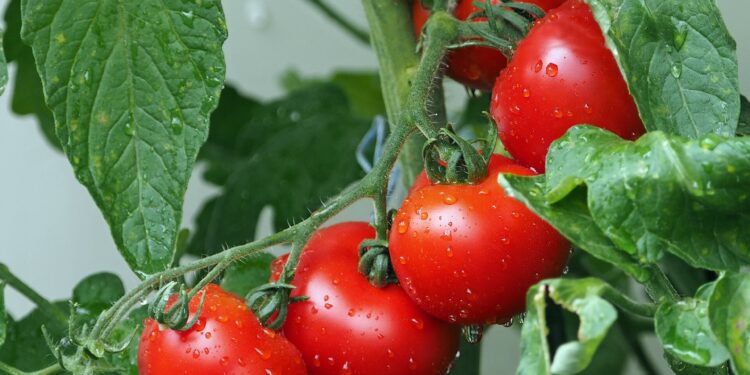Credit: Pixabay/CC0 Public domain
Plants produce a range of chemicals called volatile organic compounds that influence their interactions with the world around them. In a new study, researchers at the University of Illinois at Urbana-Champaign investigated how the type and amount of these VOCs change based on different characteristics of tomato plants.
The research is published in the Journal of Chemical Ecology.
The smell of cut grass is one of the characteristic scents of summer. Such odors are one of the ways plants signal their wounds. Because they cannot run away from danger, plants have evolved to communicate with each other using chemical signals. They use VOCs for a variety of reasons: to mount their own defenses, to warn each other of threats, to recruit beneficial soil microbes that can help plants grow, and to alert predatory insects that a pest is chewing on plant leaves. this plant.
“When a caterpillar chews a leaf, the plant sends a signal that calls out to its predators. It’s like a billboard that tells them where lunch is,” said Erinn Dady, a graduate student in Ngumbi’s lab.
Studying the factors that influence VOC emissions is therefore essential to understanding plant health. In the past, other studies have looked at how soil microbes like arbuscular mycorrhizal fungi or caterpillars or tomato plant variety can influence VOCs. In the current study, researchers investigated the collective influence of all these factors on plant chemistry using four tomato varieties: two heirlooms and two hybrids.
“Previous studies have looked at tomato varieties grown conventionally on a large scale for processing and which are not typically grown by smallholder farmers. So we decided to ask Illinois farmers what they’re growing. Based on their feedback, we chose tomato varieties that are commonly grown. grown in central Illinois,” Dady said. The hybrids used were Mountain Fresh and Valley Girl, and the organic heirlooms were Amish Paste and Cherokee Purple.
The researchers compared the responses of untreated plants to those that had been exposed to AMF, caterpillars, or both. They studied VOCs by enclosing eight-week-old tomato plants in an odor-blocking oven bag for an hour. They extracted the air around the plants and analyzed the different chemicals produced by each plant using gas chromatography-mass spectrophotometry.
AMF and caterpillars, separately, reduced volatile emissions in all four varieties of tomato plants. Their effect when they were present together was minimal compared to the effects when either was present.
Although it is unclear why the beneficial fungal associations decreased VOCs, it is concerning that the plants were not as susceptible to caterpillars. Additionally, hybrid tomatoes emitted lower amounts of volatile substances compared to heirloom tomatoes.
Esther Ngumbi, left, and Erinn Dady studied the effect of arbuscular mycorrhizal fungi, caterpillars and tomato plant variety on plant chemistry. Credit: Fred Zwicky
“Heirloom tomatoes, the big juicy tomatoes we all love, are bred for their flavor. Meanwhile, hybrids are grown for large-scale conventional production, which comes at a cost to the plant,” said Esther Ngumbi (CIS/MMG), an assistant. professor of integrative biology. “Our work suggests that we compromise plant defenses through our breeding processes.”
Plants were also evaluated based on their growth both above ground and in the ground. The researchers found that plants associated with fungi had higher leaf biomass and more complex root structures.
“AMF forms partnerships in more than 80% of land plants, creating a trade in which fungi extract nutrients from the soil in exchange for plant carbon,” Dady said. “We found that particularly in Cherokee Purple, AMF can confer additional benefits, including increased growth and greater VOC emission.”
Surprisingly, plants treated with caterpillars showed greater growth.
“These plants had more biomass in their roots and above ground, which seems counterintuitive because they were actively consumed. I suspect they would have less biomass,” Dady said. “It’s possible that the caterpillars triggered a growth response, similar to how you prune a tree to make it produce new growth.”
The researchers want to study the growth response to caterpillars in more detail.
“It’s possible that the plants decided that the number of caterpillars we were using wasn’t enough to be considered a threat and that’s why they continued to grow. It’s also possible that the caterpillars didn’t hungry enough to cause enough damage,” Ngumbi said. .
“There’s a lot going on behind the scenes that we don’t yet understand. For example, we’re barely scratching the surface in understanding the role of different microbes,” Dady said. “People tend to think that plants are not intelligent, but our studies have shown that they actively respond to the environment around them using chemistry.”
“We are trying to spread the gospel of plant chemistry, it is the language that plants use to communicate and we are eager to learn more,” Ngumbi said.
More information:
Erinn R. Dady et al, Plant variety, mycorrhization and the influence of herbivores Induced volatile emissions and plant growth characteristics in tomato, Journal of Chemical Ecology (2023). DOI: 10.1007/s10886-023-01455-w
Provided by University of Illinois at Urbana-Champaign
Quote: Talking Tomatoes: How their communication is influenced by enemies and friends (January 24, 2024) retrieved January 24, 2024 from
This document is subject to copyright. Apart from fair use for private study or research purposes, no part may be reproduced without written permission. The content is provided for information only.



